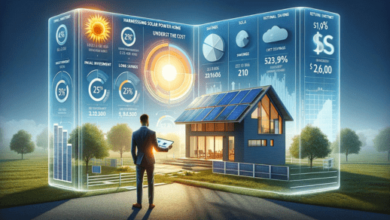Renewable Energy Tech: Harnessing Power from Sustainable Sources

As the world faces the urgent need to transition away from fossil fuels and reduce carbon emissions, renewable energy technologies have emerged as key solutions. These technologies harness power from sources that are naturally replenished, such as sunlight, wind, and water. Let’s explore the importance of renewable energy and the technologies driving this global shift toward sustainability.
The Need for Renewable Energy
Fossil fuels, while providing energy for decades, come at a significant environmental cost. The burning of coal, oil, and gas releases greenhouse gases that contribute to climate change. Renewable energy sources offer a cleaner and more sustainable alternative, helping to mitigate the negative impacts of energy production.
Solar Energy
Solar energy is perhaps the most well-known renewable energy source. Solar panels, also known as photovoltaic (PV) panels, convert sunlight into electricity. They can be installed on rooftops, in solar farms, and even integrated into various products. Advances in solar technology have led to increased efficiency and reduced costs, making solar energy more accessible.
Wind Energy
Wind energy harnesses the power of the wind to generate electricity. Wind turbines, often located in windy areas or offshore, spin in response to the wind’s force. This movement generates mechanical energy, which is then converted into electricity. Wind energy is a versatile and rapidly growing source of renewable power.
Hydropower
Hydropower converts the energy of flowing water into electricity. Dams and turbines are used to capture the kinetic energy of water in rivers and dams, transforming it into electrical energy. While large-scale hydropower plants have been used for decades, smaller run-of-the-river systems are gaining popularity.
Biomass and Bioenergy
Biomass refers to organic materials such as wood, agricultural residues, and waste. These materials can be burned to produce heat or converted into biofuels like ethanol and biodiesel. Bioenergy provides a way to utilize organic waste while reducing reliance on fossil fuels.
Geothermal Energy
Geothermal energy taps into the heat stored within the Earth’s crust. Geothermal power plants use steam or hot water from underground reservoirs to generate electricity. This source of energy is reliable and available around the clock.
Challenges and Advancements
While renewable energy technologies offer promising solutions, they also face challenges. Intermittency—variations in availability due to weather or time of day—is a challenge for solar and wind energy. Energy storage solutions, such as batteries, are crucial for storing excess energy for use when the sun isn’t shining or the wind isn’t blowing.
Advancements in energy storage, grid integration, and smart technologies are helping to address these challenges. Smart grids enable better management of energy distribution, while innovative storage solutions enhance the reliability of renewable energy sources.
Global Impact and Future Outlook
The adoption of renewable energy technologies has significant global implications. Transitioning to clean energy reduces greenhouse gas emissions, combats air pollution, and enhances energy security. Countries and regions around the world are setting ambitious renewable energy targets to accelerate the shift toward a sustainable energy future.
Conclusion
The transformation to renewable energy technologies is a pivotal step toward a greener, more sustainable world. From capturing the power of the sun and wind to harnessing the Earth’s natural heat, these technologies offer a cleaner, more abundant source of energy. As innovation continues to drive the renewable energy sector forward, the promise of a future powered by sustainable sources grows brighter each day.



